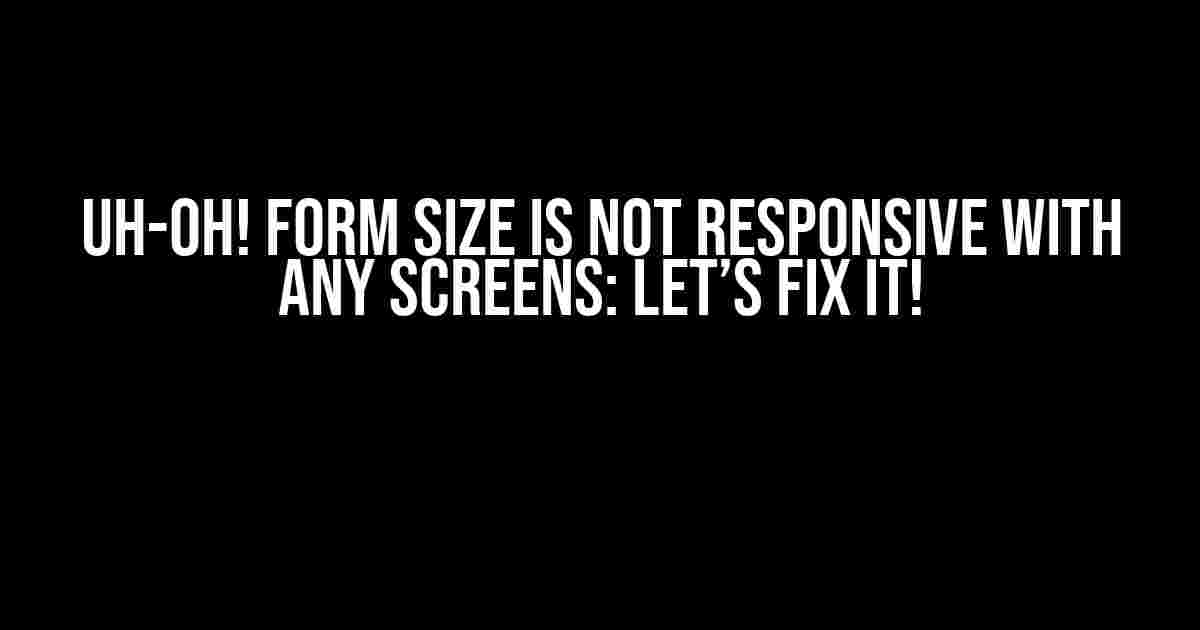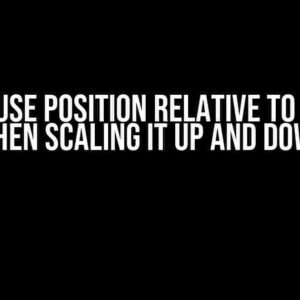Are you tired of dealing with forms that refuse to adapt to different screen sizes? You’re not alone! Many web developers and designers face this frustrating issue, but fear not, dear reader, for we’re about to dive into the world of responsive form design and emerge victorious!
What’s Going On with My Form?
Before we dive into the solution, let’s quickly discuss why your form size is not responsive with any screens. There are several reasons for this, including:
- Fixed Widths and Heights: When you set fixed widths and heights for your form elements, they won’t adjust to different screen sizes.
- Absolute Positioning: Using absolute positioning can cause form elements to overlap or disappear when the screen size changes.
- Lack of Media Queries: Failing to use media queries means your form won’t adapt to different screen sizes and devices.
- Incompatible Units: Using incompatible units like pixels (px) instead of relative units like percentages (%) or ems can cause responsiveness issues.
Let’s Get Responsive!
Now that we’ve identified the culprits, let’s create a responsive form that adapts beautifully to any screen size. We’ll use a combination of CSS, HTML, and a pinch of magic (just kidding, it’s actually just good coding practices!).
Step 1: Use Relative Units
Swap out those fixed pixels for relative units like percentages (%), ems, or rems. This will allow your form elements to scale with the screen size. For example:
_form {
width: 50%; /* 50% of the parent container */
max-width: 300px; /* Maximum width of 300px */
margin: 0 auto; /* Center the form horizontally */
}
Step 2: Apply Media Queries
Media queries are the secret sauce to responsive design. We’ll use them to apply different styles based on screen size. For example:
/* Apply styles for small screens (max-width: 480px) */
@media only screen and (max-width: 480px) {
_form {
width: 90%; /* Take up 90% of the screen width */
padding: 20px; /* Add some padding for small screens */
}
}
/* Apply styles for medium screens (min-width: 481px) and (max-width: 768px) */
@media only screen and (min-width: 481px) and (max-width: 768px) {
_form {
width: 60%; /* Take up 60% of the screen width */
padding: 30px; /* Add some more padding for medium screens */
}
}
/* Apply styles for large screens (min-width: 769px) */
@media only screen and (min-width: 769px) {
_form {
width: 40%; /* Take up 40% of the screen width */
padding: 40px; /* Add even more padding for large screens */
}
}
Step 3: Use Flexible Grids
Grid systems are your friend when it comes to responsive design. We’ll use CSS Grid to create a flexible grid that adapts to different screen sizes. For example:
_form {
display: grid;
grid-template-columns: repeat(2, 1fr); /* Create a 2-column grid with equal widths */
grid-gap: 20px; /* Add a 20px gap between grid items */
}
/* Apply styles for small screens (max-width: 480px) */
@media only screen and (max-width: 480px) {
_form {
grid-template-columns: 1fr; /* Switch to a single-column grid for small screens */
}
}
Step 4: Optimize Form Elements
We’ll optimize individual form elements using CSS and HTML attributes. For example:
<input type="text" id="name" name="name" required>
input[type="text"] {
width: 100%; /* Take up the full width of the grid cell */
padding: 10px; /* Add some padding for user comfort */
border: 1px solid #ccc; /* Add a subtle border */
}
Putting it All Together
Now that we’ve covered the individual steps, let’s put it all together in a demo form:
<form>
<label for="name">Name:</label>
<input type="text" id="name" name="name" required>
<label for="email">Email:</label>
<input type="email" id="email" name="email" required>
<label for="message">Message:</label>
<textarea id="message" name="message" required></textarea>
<button type="submit">Send</button>
</form>
_form {
width: 50%; /* Take up 50% of the parent container */
max-width: 300px; /* Maximum width of 300px */
margin: 0 auto; /* Center the form horizontally */
padding: 20px; /* Add some padding for user comfort */
background-color: #f7f7f7; /* Add a subtle background color */
border: 1px solid #ccc; /* Add a subtle border */
box-shadow: 0 0 10px rgba(0, 0, 0, 0.1); /* Add a subtle box shadow */
}
/* Apply styles for small screens (max-width: 480px) */
@media only screen and (max-width: 480px) {
_form {
width: 90%; /* Take up 90% of the screen width */
}
}
/* Apply styles for medium screens (min-width: 481px) and (max-width: 768px) */
@media only screen and (min-width: 481px) and (max-width: 768px) {
_form {
width: 60%; /* Take up 60% of the screen width */
}
}
/* Apply styles for large screens (min-width: 769px) */
@media only screen and (min-width: 769px) {
_form {
width: 40%; /* Take up 40% of the screen width */
}
}
input[type="text"], textarea {
width: 100%; /* Take up the full width of the grid cell */
padding: 10px; /* Add some padding for user comfort */
border: 1px solid #ccc; /* Add a subtle border */
}
button[type="submit"] {
background-color: #4CAF50; /* Add a subtle background color */
color: #fff; /* Add a subtle text color */
padding: 10px 20px; /* Add some padding for user comfort */
border: none; /* Remove the border */
border-radius: 5px; /* Add a subtle border radius */
cursor: pointer; /* Add a pointer cursor */
}
Conclusion
And that’s it! By following these steps, you should now have a responsive form that adapts beautifully to any screen size. Remember, responsiveness is all about flexibility, so don’t be afraid to experiment and adjust your code as needed. Happy coding!
| Screen Size | Form Width | Padding |
|---|---|---|
| Small (max-width: 480px) | 90% | 20px |
| Medium (min-width: 481px) and (max-width: 768px) | 60% | 30px |
| Large (min-width: 769px) | 40% | 40px |
Don’t forget to test your form on different devices and screen sizes to ensure it’s working as expected. Happy coding, and may the responsiveness be with you!
Have any questions or need further assistance? Feel free to ask in the comments below!
Here are 5 Questions and Answers about “Form size is not responsive with any screens”:
Frequently Asked Question
Having trouble with unresponsive form sizes? Don’t worry, we’ve got you covered! Check out our FAQs below to find the solution to your problem.
Why is my form size not adjusting to different screen sizes?
This is likely due to the fact that your form is using fixed widths and heights instead of relative units. Try using CSS units like percentages, em, or rem to make your form responsive.
How do I make my form fields scale with the screen size?
You can achieve this by using CSS media queries to define different styles for different screen sizes. For example, you can use `@media (max-width: 768px) { /* styles here */ }` to apply styles only for screen sizes below 768px.
What is the best way to test form responsiveness?
You can test form responsiveness by resizing your browser window or using a tool like the Chrome DevTools Device Mode to simulate different screen sizes. You can also use online tools like Responsinator or Screenfly to test your form across various devices and screen sizes.
Can I use Bootstrap or other CSS frameworks to make my form responsive?
Yes, you can! Bootstrap and other CSS frameworks provide pre-built classes and components that can help you create responsive forms. You can use their grid system and responsive utility classes to make your form fields and layout adapt to different screen sizes.
Are there any specific HTML and CSS codes I should use to make my form responsive?
Yes, you can use HTML and CSS codes like `meta viewport`, `@media` queries, `flexbox`, and `grid` to make your form responsive. You can also use CSS properties like `max-width`, `width`, and `height` to control the size and layout of your form fields.








